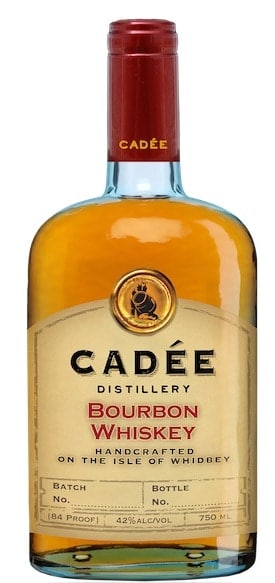
A few questions spring to mind. First, what exactly is a “Scottish-style distillery?” One that makes single-malt whiskey? (Cadre doesn’t, at least not yet anyhow). Second, does literally anyone else call Whidbey Island, Washington “the Isle of Whidbey”? (No). Finally, how, exactly, is Whidbey’s “pure air, water, and soil” utilized in the production of Cadée’s spirits?
The answer to that last question, so far, is unclear: on one hand, contrary to the romantic field-to-glass images the distillery aims to conjure in its marketing, the whiskey I tried—their bourbon—is quite clearly labeled “distilled in Indiana.” On the other hand, Campbell has said he’s building a facility on Whidbey Island where he’ll be able to do actual distilling. He also reports a single malt is in the works.
But the Cadée bourbon, like so many others, seems to be sourced (MGP) whiskey, only in this case it has been aged in-house at Cadée and dressed up as a carefully-crafted, small batch spirit.
In any case, it’s aged “a minimum of eight months” and bottled at 84 proof.
Tasting Notes:
Color: Light amber
Nose: Sweet overall, dominated by butterscotch, vanilla, and caramel. Some banana is also noticeable, as is a hint of charcoal.
Palate: Rich and sweet, with a soft, creamy mouthfeel. Honey and crème brûlée mingle with a light nuttiness, giving the impression of a banana cream pie. Finishes with faintly bitter oak.
Overall, this is a perfectly decent bourbon. There’s a reason so many small distilleries bottle MGP juice, especially in their early years, and it’s because an industrial-scale distiller can very often turn out a better, more consistent product than a start-up can.
That said, I find it a dishonest tactic to imply to consumers they’re getting a small-batch whiskey backed by a 500-year-old family legacy when they buy the stuff. If you’re interested, you can pick up a bottle for around $40.
Final score: 84/100 [SHOP FOR A BOTTLE OF CADEE BOURBON]






